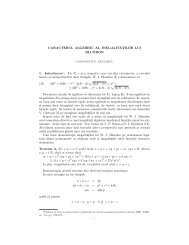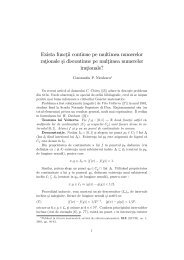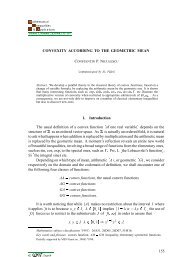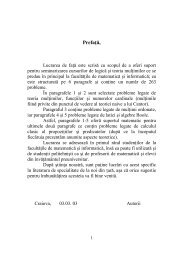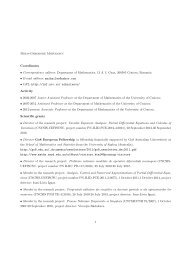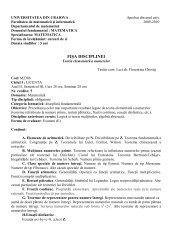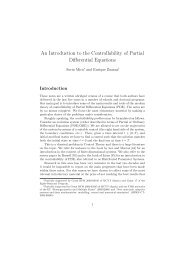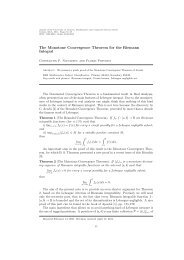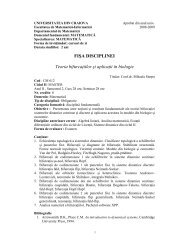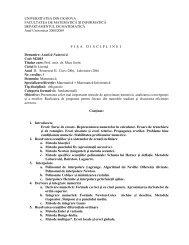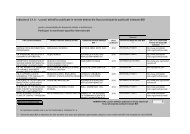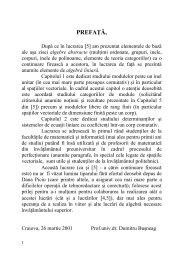PROBLEMS AND SOLUTIONS
PROBLEMS AND SOLUTIONS
PROBLEMS AND SOLUTIONS
You also want an ePaper? Increase the reach of your titles
YUMPU automatically turns print PDFs into web optimized ePapers that Google loves.
Since the sine function is concave down on (0, π), Jensen’s inequality gives|MA|R b + R c+|MB|R a + R c+|MC|R a + R b≤ 3 sin π 6 = 3 2 .Equality holds if and only if all the ϕ i are π/6, that is, if and only if ABC is equilateraland M is its center.Editorial comment. Pál Péter Dályay and Marian Dincă (independently) remarked thatthe problem and solution generalize as follows. Let M be a point in the interior ofthe convex n-gonA 1 · · · A n (with all indices interpreted mod n). With R k denoting thecircumradius of triangle M A k A k+1 , we haven∑ |MA k |≤ n cos π R k−1 + R k n ,k=1with equality if and only if the n-gon is regular and M is its center.Also solved by G. Apostolopoulos (Greece), M. Bataille (France), M. Can, R. Chapman (U. K.), P. P. Dályay(Hungary), M. Dincă (Romania), W. Jiang (China), O. Kouba (Syria), C. R. Pranesachar (India), J. Schlosberg,R. A. Simon (Chile), J. Simons (U. K.), R. Smith, T. Smotzer, R. Stong, M. Tetiva (Romania), Z. Vörös(Hungary), J. B. Zacharias & K. T. Greeson, GCHQ Problem Solving Group (U. K.), and the proposer.Gamma and Beta Inequalities11542 [2010, 929]. Proposed by Cezar Lupu, student, University of Bucharest,Bucharest, Romania, and Vicenţiu Rădulescu, Institute of Mathematics “SimionStoilow” of the Romanian Academy, Bucharest, Romania. Show that for x, y, z > 1,and for positive α, β, γ ,and(2x 2 + yz)Ɣ(x) + (2y 2 + zx)Ɣ(y) + (2z 2 + xy)Ɣ(z)≥ (x + y + z)(xƔ(x) + yƔ(y) + zƔ(z)),B(x, α) x2 +2yz B(y, β) y2 +2zx B(z, γ ) z2 +2xy≥ (B(x, α)B(y, β)B(z, γ )) xy+yz+zx .Here, B(x, α) is Euler’s beta function, defined by B(x, α) = ∫ 10 t x−1 (1 − t) α−1 dt.Solution by M. A. Prasad, India. The first inequality is equivalent to(x − y)(x − z)Ɣ(x) + (y − z)(y − x)Ɣ(x) + (z − x)(z − y)Ɣ(z) ≥ 0.It is symmetric in x, y, z, so we may assume x ≥ y ≥ z. The first and third terms arenonnegative, and the middle term is nonpositive. Note also that Ɣ(x) is a convex functionfor x > 0, since (d 2 /dx 2 )Ɣ(x) = (log x) ∫ 2 ∞e −t t x−1 dx ≥ 0. Therefore, Ɣ(y) ≤0max{Ɣ(x), Ɣ(z)}. Since |(y − z)(y − x)| ≤ min{(x − y)(x − z), (z − x)(z − y)}, oneof the nonnegative terms is at least as large as the nonpositive term in absolute value.This completes the proof for the first inequality. The second inequality is incorrect. Fora counterexample, consider x > y > z, and α, γ very large, and β = 1. The inequalityis equivalent toB(x, α) (x−y)(x−z) B(y, β) (y−z)(y−x) B(z, γ ) (z−x)(z−y) ≥ 1.Now as α, γ → ∞, we have B(x, α), B(z, γ ) → 0, so the left side is less than 1.Also solved by G. Apostopoulos (Greece), R. Bagby, R. Chapman (U. K.), P. P. Dályay (Hungary), R. Stong,J. V. Tejedor (Spain), and GCHQ Problem Solving Group (U. K.)June–July 2012] <strong>PROBLEMS</strong> <strong>AND</strong> <strong>SOLUTIONS</strong> 529



